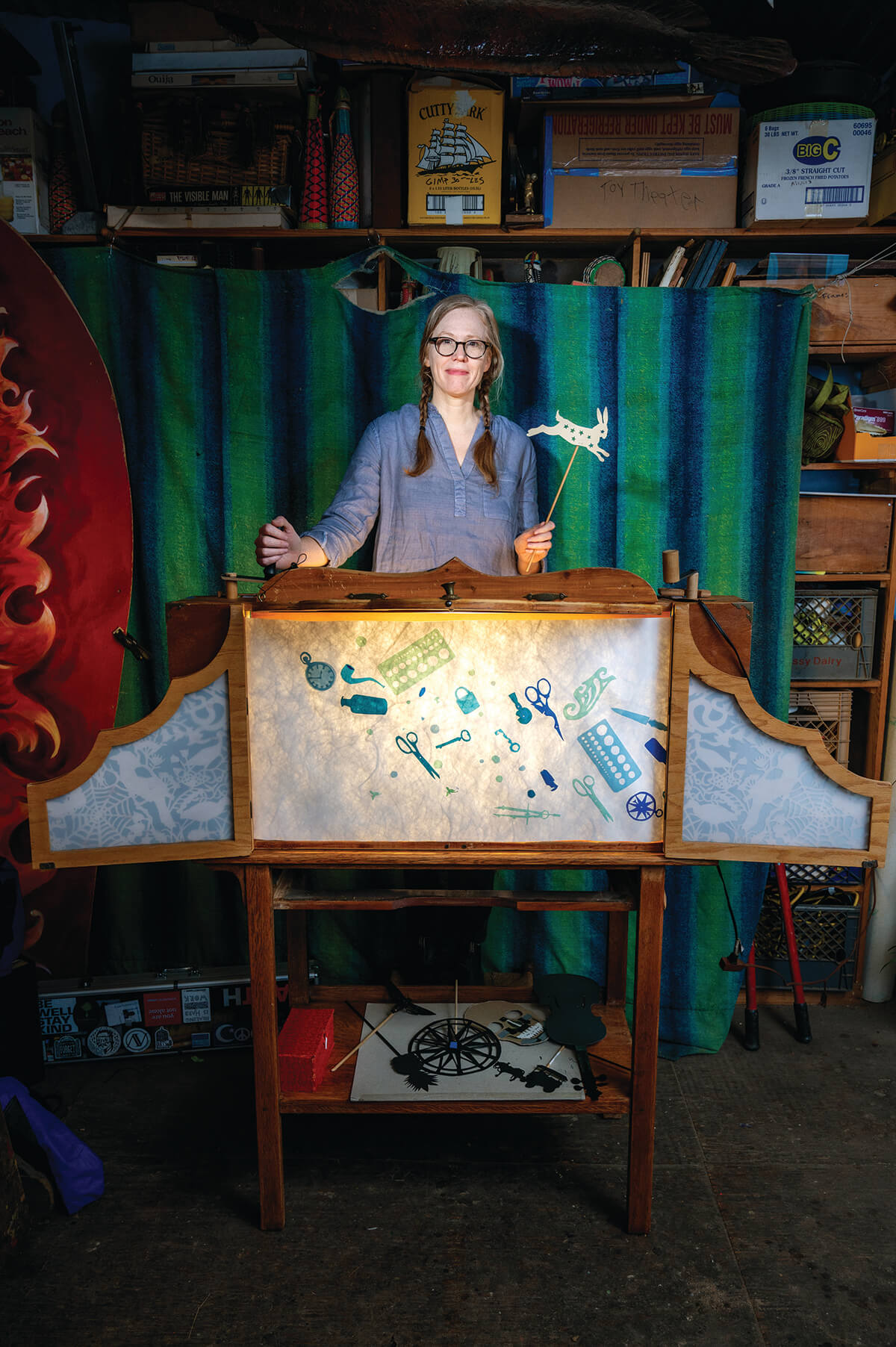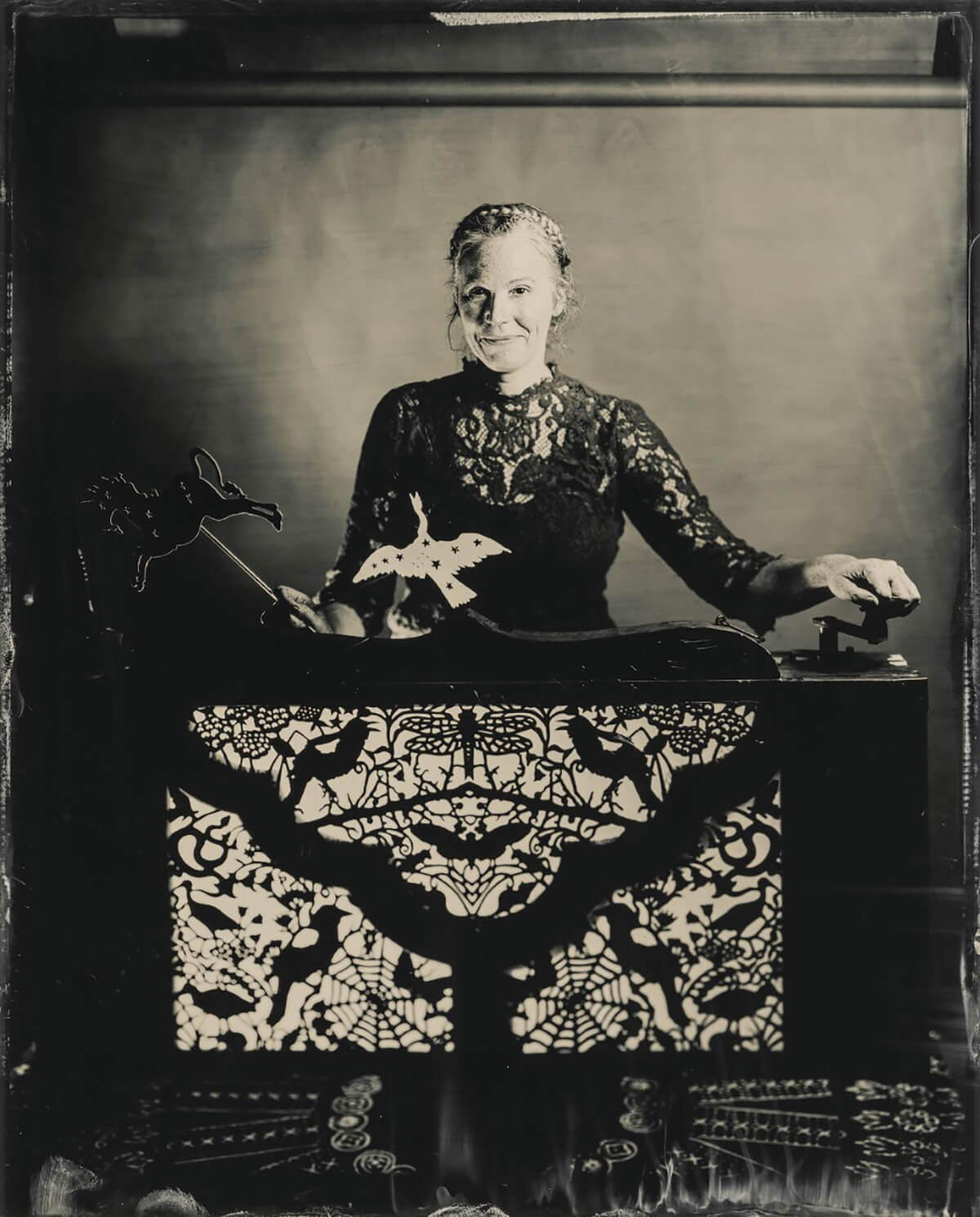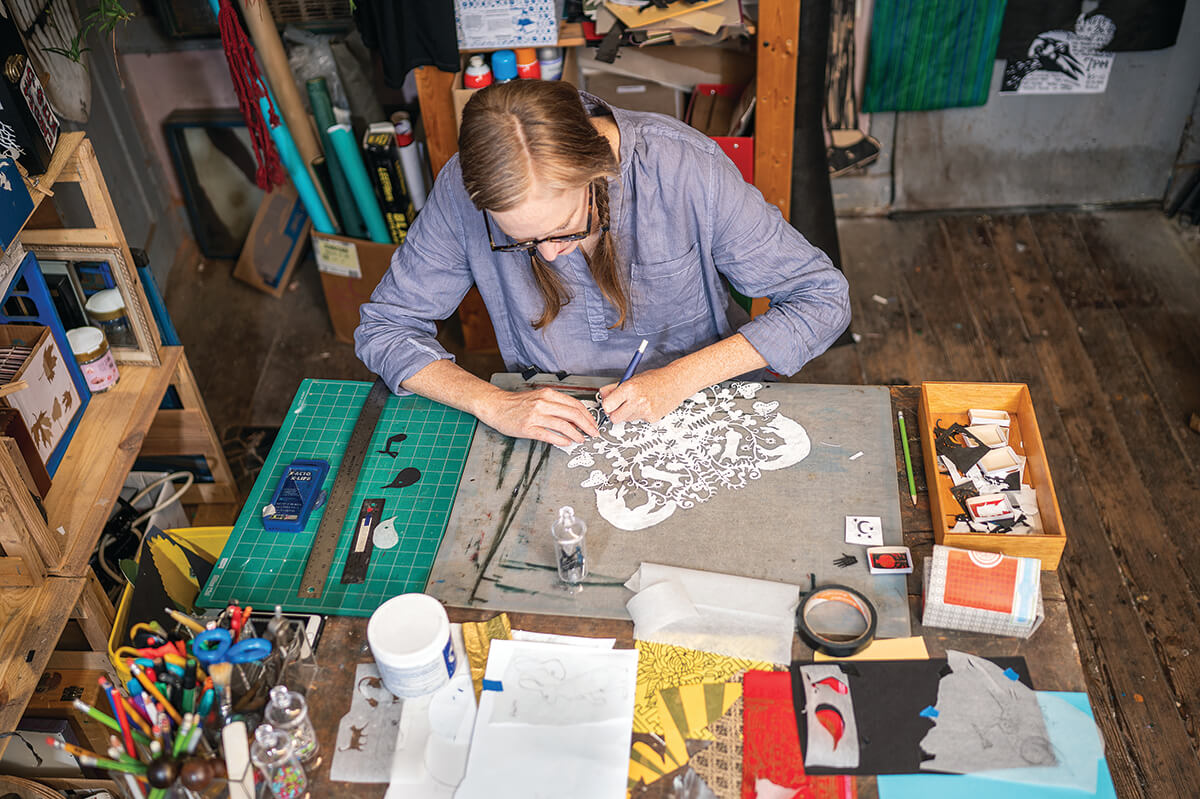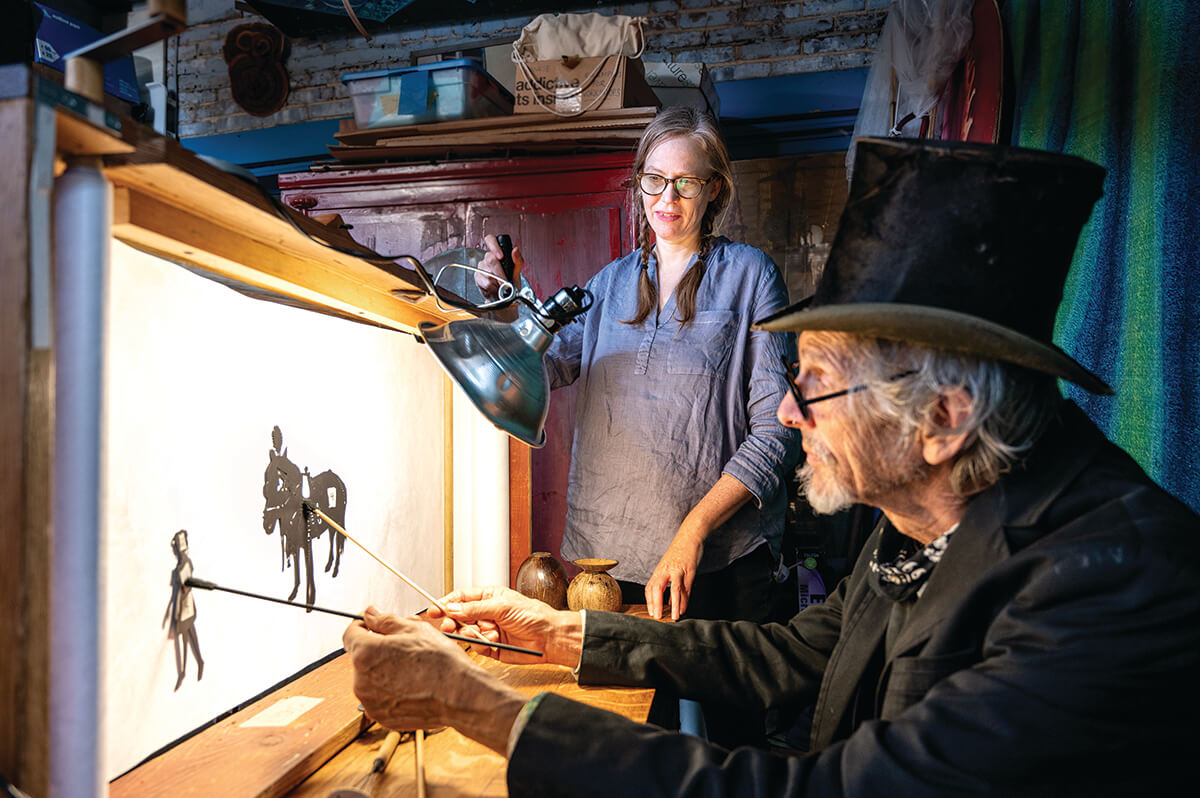Arts & Culture
Crankies Artist Katherine Fahey Inspires Baltimore With the All-But-Lost Folk Art
How the 19th-century practice that combines storytelling and a hand-cranked scroll of illustrated images became Fahey's niche.

When Katherine Fahey was in grade school, one assignment changed the course of her destiny. She was tasked with creating a papercutting, but instead of the usual hearts or snowflakes fifth-graders might make, she challenged herself to cut a panda bear in the middle of a bamboo patch.
The homework came at a time when Fahey was sick and had to stay home from school for a couple days. She remembers spending hours in bed, likely with a fever, slowly cutting by hand her intricate image.
“I go back to school and have this amazing papercut, and my teacher was like, ‘Wow,’” Fahey recalls. “I think that was the first time someone had said to me, ‘You’re an artist.’ People had known my drawing before that, but I remember that being the year when teachers started saying things to me like, ‘It’s okay you’re not good at science.’”
Suffice it to say, her papercuttings have become even more elaborate over the years. But it was the discovery of “crankies”—the 19th-century art form that combines storytelling and a hand-cranked scroll of illustrated images—that allowed her to integrate her work as a papercut artist, shadow puppeteer, and vocalist with her love of folk tales.
Crankies, in a word, became her niche—so much so that she’s now known as the Godmother of Baltimore Crankies, the Jane Appleseed of Crankies, or the Matron Saint of Crankies, depending on whom you ask, and her devotion to the all-but-lost art form has had a ripple effect on the Baltimore arts community.
In addition to helping found the annual, wildly popular Crankie Fest at the Creative Alliance with folk duo Anna & Elizabeth—which was set to return Jan. 7-9 but has since been postponed until May 20-22 due to COVID-19—Fahey has toured her crankies around the U.S. and leads workshops for students young and old. All the while, as the city has become known as the epicenter of mechanical, often musical, moving picture shows, she’s continued to empower others to tell their own stories.
“It’s so inspiring,” says Lauraville crankie artist Liz Downing. “You see people at [crankie] shows go, ‘I’d like to do that. I have a story.’ Anyone can create a crankie and have it be meaningful. Kathy, I think, has inspired the crankies to continue. The festival is just once a year, but she takes her work all over the city. It’s just a beautiful Baltimore thing.”
Though they were called moving panoramas at the time, crankies began in the 1800s as a way to expand upon the fashionable panoramic paintings of the era. Artists began creating long paintings that were wrapped around two large spools on either end and hand-cranked to create a scrolling story with a beginning, middle, and end, rather than a static image. It was, in effect, the beginnings of modern cinema.
These moving panoramas were toured throughout the world, transporting people to new places and cultures they’d never seen. Some were created to encapsulate and preserve the stories of historical events. Others depicted astonishing geographical features (voyages to the Arctic) or impressive urban development (a train ride from London to Paris). Several depicted the Mississippi River and included the towns and stories that ran alongside it, the most famous being John Banvard’s painted crankie that was said to be three miles long. Sometimes the scrolls acted as backdrops to plays, revealing changing scenery. Mostly, the crankies were accompanied by a storyteller and served as the main focal point of the performance.
Crankies all but disappeared with the advent of motion pictures at the turn of the century. As far as anyone knows, next to none were made for the next 100 years. Almost imperceptibly, a slow but steady resurgence began, and now, modern tools have evolved the art form into new directions.
Fahey’s first exposure to crankies came about a decade ago through Philadelphia-based shadow puppet and papercut artist Erik Ruin. “I just thought, I don’t know what that is, but I want to do that,” Fahey recalls. “I started basically forcing my friends to make shadow puppets with me at parties.”


Meanwhile, the acclaimed Baltimore indie duo Wye Oak—Jenn Wasner and Andy Stack—who had recently signed with a label and had been to a few of these parties, needed a music video. They asked Fahey if she would create one with her papercuttings and shadow puppets. Thus began Fahey’s first crankie, a vertical scroll that was filmed for the song “Fish,” which has since been viewed more than 255,000 times on YouTube.
But it was another house party, where Fahey met Virginia-based old-time music duo Anna & Elizabeth, that would prove to be even more pivotal. A mutual Baltimore friend, musician Caleb Stine, kept insisting that she come to his upcoming house show, without revealing why. Once there, Fahey was spellbound by Anna & Elizabeth performing their music alongside a crankie they’d made to illustrate the songs.
“Kathy saw our crankie and was just very sweetly complimentary, saying that our show really resonated with her,” recalls Elizabeth LaPrelle. “She told us she was making a crankie, too.”
They became fast friends, especially after Anna Roberts-Gevalt moved to Baltimore, and they toured their crankies together throughout New England. They also co-founded Crankie Fest in 2014, with the help of Josh Kohn, performance director at the Creative Alliance. The winter tradition would prove to be not only an annual must-see for audiences but a major boost for the art form.
“Because of Kathy and Anna & Elizabeth, the crankie community here in Baltimore became so much more prolific,” says Valeska Populoh, who teaches puppetry at Maryland Institute College of Art and co-founded Black Cherry Puppet Theater’s Puppet Slams. “People making them here would go tour with them and meet people who were making them in other places, and then those people would come here, so it sort of built a totally new ecology around crankies.”
In its first years, Crankie Fest organizers reached out to artists, storytellers, and musicians in the Baltimore area, asking them to make crankies for the festival—though often after first having to explain what a crankie is.
Liz Downing, for example, had been a longtime visual artist and performer and had created visual components for plays, like costumes and set designs, but, similar to Fahey, she’d never rolled all of her various art forms into one until she was invited to make a scroll and perform for Crankie Fest. Now it’s a medium she returns to again and again. Populoh, too, was inspired by the festival to make her first crankie, “The Holy Land,” which she used as a vehicle to protest the building of a new city incinerator.
“It’s lovely to be drawn into the intimacy of the performance. I think for many people, there’s something very grounded and calming about experiencing someone telling a story this way,” Populoh says. “We live in a world where there are images flooding our eyes and minds all the time, and we have access to all of this high-tech equipment, all of these digital tricks. What I’m really drawn to with crankies is the accessibility in a world that is so deeply inequitable. If you have a story to tell and you have some basic materials, you can tell a compelling story. And I think we need that. The need to make sense of the lives we’re living is so fundamental and so ancient.”
Soft-spoken and studious, Fahey has always been drawn to folk art in various forms. Upon reflection, she realized most of her close friends practice such old-world arts as well—painting, sewing, quilting. She’s also attracted to old-fashioned objects and abandoned things, often incorporating them into her sculptural work as a student at MICA.
Fahey credits her father with instilling in her an appreciation for these crafts of yesteryear. He was sick for most of his life and worked from home as a mapmaker. His large basement studio impressed upon Fahey from a young age the marvels of old tools, lightboxes, and darkrooms. He was a cartographer at a time when the practice was quickly shifting to become computer-based. Students who’d gone to school for cartography, in fact, would email him every week, Fahey remembers. He was also the first person to put an X-ACTO knife in Fahey’s hand, “probably younger than most,” she says with laugh. “He would set me up and let me draw at the tables.”
Before beginning a new crankie, Fahey researches her subject tirelessly, reading old folktale books and whatever she can get her hands on. She finds stories she thinks need to be told, ones that might otherwise be forgotten.
She’s made a crankie about Elizabeth Whitmore, a midwife pioneer in Vermont during Colonial times who survived a winter alone with her daughter—while also traveling by horse or canoe, day or night, to help women deliver their babies.
“It’s people like that that make me want to tell stories,” Fahey says. “There are these personal stories of people who are kind of forgotten—nobody knows who they are, they’re never gonna be on TV, they’re never gonna have a book written about them. Here was this woman who was so amazing.”
Another of her crankies tells the story of the arabbers in Baltimore, who have a stable behind her house. “We are the only city in the U.S. with horse-cart vendors,” Fahey explains, “and with some of these guys, their grandfathers did this or it was their family’s way to support themselves when they came out of slavery. It’s really meaningful. It’s not just a career choice.”
She’s also created a crankie about a native Inuit folktale and invited Inuit throat singers to the stage to perform it with her. Perhaps her most personal crankie, though, told the story of her father after he passed. She used various birds as metaphors to show what her father was like and how he inspired her to be an artist and follow her heart.
“She deeply cares about her stories,” says Creative Alliance’s Kohn, adding Fahey is the only artist to have performed at every Crankie Fest. “She has an open invitation, and every year, she surprises us with something new.”
After finding her story, Fahey works in the studio space she shares with her partner, artist Dan Van Allen, in their 19-room home—and creates papercut images to illustrate the story. Then, she lays out her quilt-like cuttings along a scroll, sometimes 100-feet long, as you would a storyboard, rearranging as needed. Rather than paper, she uses the more durable Tyvek house wrap (the stuff new homes are wrapped in) to create her scrolls—a tactic others have adopted.
The scroll is then wound around two hand cranks inside a wooden box that’s backlit with a lightbulb. Handmade shadow puppets bring additional movement to the scrolling crankie. One of her more recent puppets is a serpent whose eyes, tongue, and tail movements she controls with a single finger.

Fahey eased into the performance aspect incrementally—from making papercuttings to filming them as moving images and ultimately to performing her crankies live with story and song.
“The two things I always said I’d never be were a teacher and a performer, and now I’m both,” Fahey says, chuckling. “I was the shyest, shyest, shyest kid. I’d started singing because my father was so worried about how shy I was. He was like, ‘I really think you should join the choir. I really think it would be good for you.’”
LaPrelle remembers Fahey being quite nervous about performing when they first went on tour together, “but now she says it’s her favorite part.”
When the pandemic started, Fahey and Van Allen transformed their van to include a pullout stage and began traveling to neighborhoods throughout the city to deliver outdoor, COVID-19-safe crankie performances, like a traveling medicine show.
“The sidewalk is just as good to her as a theater,” says Downing, who caught one of their outdoor performances near her Lauraville neighborhood. “It was just such a beautiful relief to have art and people gathered during the pandemic.”
They’ve performed in yards, at parks, in cul-de-sacs, on rowhouse porches—anywhere that neighbors can gather together in a safe way. All they need is an extension cord.
“I love the low-tech, do-it-yourself accessibility of crankies,” says Van Allen. “At Light City, artists had millions of dollars worth of lighting and flashing lights and all kinds of lasers and gimmicks, and we have a big crowd gathered with one light bulb.”
Sometimes Van Allen, an accomplished artist in his own right, will read his poetry before one of Fahey’s shows. Often, he also acts as the shadow puppeteer and sound effects guy—replicating the jingling bells and clop-clop-clopping of the arabbers’ horses, and the singing of neighborhood birds.
“It’s really fun and exciting to be able to make crankies, because I can be a low-budget, independent artist,” Fahey says. “When I was in college, I was like, ‘Oh no. I want to be an artist, but I don’t want to mass produce art, I don’t want to make elitist art, I don’t want to make art that’s for galleries only,’ and this was the thing I puzzled over for 20 years—how do I do that? When I started making the crankies, I thought, ‘This is how I do it.’ I don’t have to compromise my way of being in the world.”